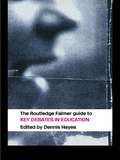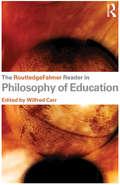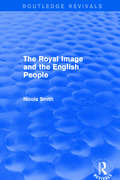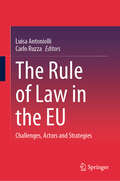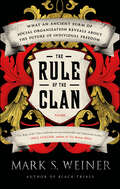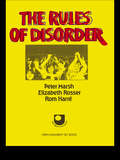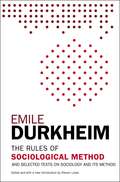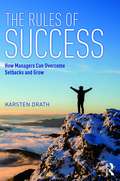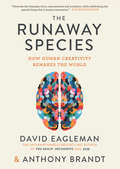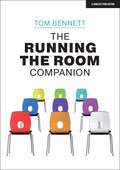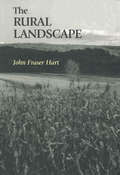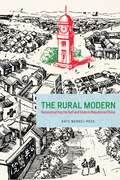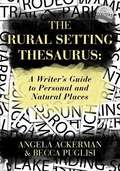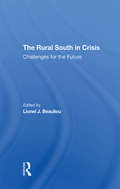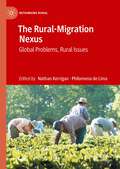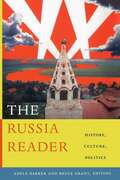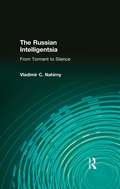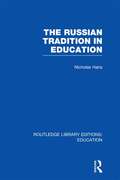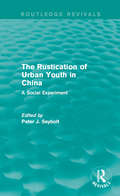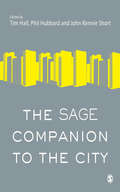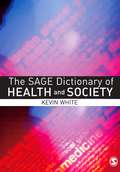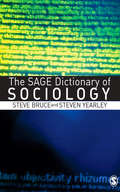- Table View
- List View
The Routledge Social Science Handbook of AI (Routledge International Handbooks)
by Anthony ElliottThe Routledge Social Science Handbook of AI is a landmark volume providing students and teachers with a comprehensive and accessible guide to the major topics and trends of research in the social sciences of artificial intelligence (AI), as well as surveying how the digital revolution – from supercomputers and social media to advanced automation and robotics – is transforming society, culture, politics and economy. The Handbook provides representative coverage of the full range of social science engagements with the AI revolution, from employment and jobs to education and new digital skills to automated technologies of military warfare and the future of ethics. The reference work is introduced by editor Anthony Elliott, who addresses the question of relationship of social sciences to artificial intelligence, and who surveys various convergences and divergences between contemporary social theory and the digital revolution. The Handbook is exceptionally wide-ranging in span, covering topics all the way from AI technologies in everyday life to single-purpose robots throughout home and work life, and from the mainstreaming of human-machine interfaces to the latest advances in AI, such as the ability to mimic (and improve on) many aspects of human brain function. A unique integration of social science on the one hand and new technologies of artificial intelligence on the other, this Handbook offers readers new ways of understanding the rise of AI and its associated global transformations. Written in a clear and direct style, the Handbook will appeal to a wide undergraduate audience.
The RoutledgeFalmer Guide to Key Debates in Education
by Dennis HayesDebating is out of fashion. No one raises the question of what has gone wrong when the entire political project of a society is seemingly reduced to 'education, education, education'.The aim of this lively and challenging book is to provide the stimulus for further thinking about key educational issues by exposing and explaining the assumptions behind this obsession. Over forty contributors, all experts in their fields, have written short, accessible, informed and lively articles for students, teachers and others involved in education. They address broad questions that are central to any understanding of what is really going on in the education system.Topics covered include: the new relationship of the state to education; the changed nature of schools; whether teachers are afraid to teach; the problems with circle time, anti-bullying strategies, citizenship education, and multiple intelligences; the retreat from truth and the demise of theory in teacher training, and much more. Everyone learning to teach in primary and secondary schools and further education colleges will find this book relevant to their programmes. In particular the book would be useful for students on Education Studies courses.
The RoutledgeFalmer Reader in the Philosophy of Education (Routledgefalmer Readers In Education Ser.)
by Wilfred CarrThis Reader brings together a wide range of material to present an international perspective on topical issues in philosophy of education today. Focusing on the enduring trends in this field, this lively and informative Reader provides broad coverage of the field and includes crucial topics.With an emphasis on contemporary pieces that deal with issues relevant to the immediate real world, this book represents the research and views of some of the most respected authors in the field today. Wilfred Carr also provides a specially written introduction which provides a much-needed context to the role of philosophy in the current educational climate.Students of philosophy and philosophy of education will find this Reader an important route map to further reading and understanding.
The Royal Image and the English People
by Nicola SmithThis title was first published in 2001. For the English people, the image of the monarchy is deeply bound up with the idea of nationhood. This book surveys aspects of England's royal heritage dialogue from the late middle ages to the 19th century. It concentrates on monumental sculpted portraits because that was the way in which the image of the monarchy was customarily presented in the most immediate and permanent form at large scale in the public arena. The aim of such memorials was to consolidate and commemorate shared loyalties and beliefs, focusing on the monarchs. They were sometimes protected by railings, more often than just by their talismanic value. There was widespread resistance to the idea that Oliver Cromwell should be commemorated by public memorial. The English generally remained uncomfortable with the idea of republicanism. The monarchial government of the middle ages, thought to be sanctioned by God, was very different from the figurehead the monarchy has become.
The Rule of Law in the EU: Challenges, Actors and Strategies
by Carlo Ruzza Luisa AntoniolliThis book reflects on the nature of the rule of law in the European Union and the present and future consequences of the attacks that are undermining it. Presenting various case studies, it analyses violations of the rule of law and their impact on the quality of European democracy and on the workings of civil and political society. Written from an interdisciplinary perspective, the book connects legal aspects related to infringements of the rule of law with their political and sociological consequences at both a general and the EU level.The book is divided into three parts. The first focuses on the rule of law in the European context and the threats to democracy posed by its violations. It examines how populist movements and parties utilize the erosion of the checks and balances in liberal democracies to weaken resisting intermediate bodies, such as dissenting civil society groups. The second part concentrates on the political perspectives, which it approaches both in terms of its general features and through a set of case studies related to violations of the rule of law. The third part provides a legal perspective on these issues and examines the impact of the rule of law and its infringement in several areas, impacting both the internal and external dimensions of the EU.
The Rule of the Clan: What an Ancient Form of Social Organization Reveals About the Future of Individual Freedom
by Mark S. WeinerA revealing look at the role kin-based societies have played throughout history and around the worldA lively, wide-ranging meditation on human development that offers surprising lessons for the future of modern individualism, The Rule of the Clan examines the constitutional principles and cultural institutions of kin-based societies, from medieval Iceland to modern Pakistan. Mark S. Weiner, an expert in constitutional law and legal history, shows us that true individual freedom depends on the existence of a robust state dedicated to the public interest. In the absence of a healthy state, he explains, humans naturally tend to create legal structures centered not on individuals but rather on extended family groups. The modern liberal state makes individualism possible by keeping this powerful drive in check—and we ignore the continuing threat to liberal values and institutions at our peril. At the same time, for modern individualism to survive, liberals must also acknowledge the profound social and psychological benefits the rule of the clan provides and recognize the loss humanity sustains in its transition to modernity. Masterfully argued and filled with rich historical detail, Weiner's investigation speaks both to modern liberal societies and to developing nations riven by "clannism," including Muslim societies in the wake of the Arab Spring.
The Rules of Disorder
by Rom Harre Peter Marsh Elizabeth RosserFirst published in 1980. Routledge is an imprint of Taylor & Francis, an informa company.
The Rules of Sociological Method: And Selected Texts on Sociology and its Method (Contemporary Social Theory Ser.)
by Emile Durkheim Steven LukesConsidered a landmark work when it was first published in 1895, The Rules of Sociological Method represents Emile Durkheim's manifesto for sociology. He argues forcefully for the objective, scientific, and methodological underpinnings of sociology as a discipline and establishes guiding principles for future research. With a substantial new introduction by the leading Durkheim scholar Steven Lukes, the book explains and sets into context Durkheim's argument. The still-controversial debates about The Rules of Sociological Method's six chapters are examined and their relevance to present-day sociology is discussed. The edition also includes Durkheim's subsequent thoughts on method in the form of articles, debates with scholars from other disciplines, and letters. This is an essential resource for students and scholars hoping to deepen their understanding of one of the pioneering voices in modern sociology and twentieth-century social thought. Durkheim's methodology is still relevant today. With substantial notes on context, this revised edition will greatly ease the task of students and scholars studying Durkheim and will engage a new generation of readers with his rich contribution to the field.
The Rules of Success: How Managers Can Overcome Setbacks and Grow
by Karsten DrathThis book is about the rules of long-term professional success. The international study on which this book is based suggests that success is, above all, one thing: the quest for a combination of happiness and satisfaction, coupled with economic independence. However, the data also suggest that the definition of success varies significantly from person to person. And furthermore, it seems like success is not an objective quality, but at least partly it results from a process of comparison with a peer group - which means in turn that the selection of your peer group is crucial for your perceived level of success in life. The author argues that, in fact, certain success factors do exist and that they are fewer in number than one might think. But above all, if we look thoroughly at the lives of truly successful people, it soon becomes apparent that success primarily has to do with overcoming setbacks, failure and crisis. This ability to effectively process adversity is also known as resilience. Because of its criticality for success this concept is discussed in greater depth using the FiRE model (Factors improving Resilience Effectiveness) as a structure. This concept has been developed by the author through many years of research. It differs from existing models due to its holistic approach including analysing different disciplines of science such as biology, medicine, brain research, epigenetics, sociology, psycho-neuro-immunology etc.
The Runaway Species: How human creativity remakes the world
by Anthony Brandt David Eagleman&“The authors look at art and science together to examine how innovations—from Picasso&’s initially offensive paintings to Steve Jobs&’s startling iPhone—build on what already exists and rely on three brain operations: bending, breaking and blending. This manifesto . . . shows how both disciplines foster creativity.&” —The Wall Street JournalThe Runaway Species is a deep dive into the creative mind, a celebration of the human spirit, and a vision of how we can improve our future by understanding and embracing our ability to innovate. David Eagleman and Anthony Brandt seek to answer the question: what lies at the heart of humanity&’s ability—and drive—to create?Our ability to remake our world is unique among all living things. But where does our creativity come from, how does it work, and how can we harness it to improve our lives, schools, businesses, and institutions?Eagleman and Brandt examine hundreds of examples of human creativity through dramatic storytelling and stunning images in this beautiful, full–color volume. By drawing out what creative acts have in common and viewing them through the lens of cutting–edge neuroscience, they uncover the essential elements of this critical human ability, and encourage a more creative future for all of us.&“The Runaway Species approach[es] creativity scientifically but sensitively, feeling its roots without pulling them out.&” —The Economist
The Running the Room Companion: Issues in classroom management and strategies to deal with them
by Tom BennettIn Running the Room: The Teacher's Guide to Behaviour, Tom Bennett rewrote the book on behaviour management, and outlined the psychology and dynamics underpinning student habits. In this companion, he goes into more detail about how to apply those principles to the classroom. Addressing a wide range of circumstances, he explores popular teacher dilemmas such as:How to deal with students who are late?What are the best ways to work with parents?Managing cover lessons successfullyHow to tame smartphonesThe best way to design a seating planHow to start the lesson for the first timeDealing with low-level disruptionGetting the class quiet when you – and they – need it the mostAnd many more. Using practical examples and evidence-informed techniques, Tom demystifies the puzzles that complex behaviour often presents, and guides teachers new and old carefully to a better understanding of how to run the room they way everyone deserves.
The Running the Room Companion: Issues in classroom management and strategies to deal with them
by Tom BennettIn Running the Room: The Teacher's Guide to Behaviour, Tom Bennett rewrote the book on behaviour management, and outlined the psychology and dynamics underpinning student habits. In this companion, he goes into more detail about how to apply those principles to the classroom. Addressing a wide range of circumstances, he explores popular teacher dilemmas such as:How to deal with students who are late?What are the best ways to work with parents?Managing cover lessons successfullyHow to tame smartphonesThe best way to design a seating planHow to start the lesson for the first timeDealing with low-level disruptionGetting the class quiet when you – and they – need it the mostAnd many more. Using practical examples and evidence-informed techniques, Tom demystifies the puzzles that complex behaviour often presents, and guides teachers new and old carefully to a better understanding of how to run the room they way everyone deserves.
The Rural Landscape
by John Fraser HartFrom the acclaimed landscape historian and geographer, a comprehensive handbook to understanding the elements that make up the rural landscape.Selected by Choice Magazine as an Outstanding Academic TitleIn this book, John Fraser Hart offers a comprehensive handbook to understanding the elements that make up the rural landscape—those regions that lie at or beyond the fringes of modern metropolitan life. Though the last two centuries have seen an inversion in the portion of people living on farms to those in cities, the land still beckons, whether traversed in a car or train, scanned from far above, or as the locus of our food supply or leisure. The Rural Landscape provides a deceptively simple method for approaching the often complex and variegated shape of the land. Hart divides it into its mineral, vegetable, and animal components and shows how each are interdependent, using examples from across Europe and America. Looking at the land forms of southern England, for instance, he comments on the use of hedgerows to divide fields, the mineral or geomorphological features of the land determining where hedgerows will grow in service of the human animal's needs. Hart reveals the impact on the land of human culture and the basic imperative of making a living as well as the evolution of technical skills toward that end (as seen in the advance of barbed wire as a function of modern transportation).Hart describes with equal clarity the erosion of land to form river basins and the workings of a coal mine. He charts shifting patterns of crop rotation, from the medieval rota of food (wheat or rye), feed (barley or oats), and fallow (to restore the land) to modern two-crop cycle of corn and soybeans, made possible by fertilizers and pesticides. He comments on traditions of land division (it is almost impossible to find a straight line on a map of Europe) and inventories a variety of farm structures (from hop yards and oast houses to the use of dikes for irrigation). He identifies the relict features of the landscape—from low earthen terraces once used in the southern United States to prevent erosion to old bank buildings that have become taverns and barns turned into human homes. Carrying the story of the rural landscape into our frantic era, he describes the "bow wave"where city life meets rural agriculture and plots the effect of recreation and its structures on the look of the land.
The Rural Modern: Reconstructing the Self and State in Republican China
by Kate Merkel-HessDiscussions of China's early twentieth-century modernization efforts tend to focus almost exclusively on cities, and the changes, both cultural and industrial, seen there. As a result, the communist peasant revolution appears as a decisive historical break. Kate Merkel-Hess corrects that misconception by demonstrating how crucial the countryside was for reformers in China long before the success of the communist revolution. In The Rural Modern, Merkel-Hess shows that Chinese reformers and intellectuals created an idea of modernity that was not simply about what was foreign and new, as in Shanghai and other cities, but instead captured the Chinese people's desire for social and political change rooted in rural traditions and institutions. She traces efforts to remake village education, economics, and politics, analyzing how these efforts contributed to a new, inclusive vision of rural Chinese life. Merkel-Hess argues that as China sought to redefine itself, such rural reform efforts played a major role, and tensions that emerged between rural and urban ways deeply informed social relations, government policies, and subsequent efforts to create a modern nation during the communist period.
The Rural Setting Thesaurus: A Writer's Guide to Personal and Natural Places
by Angela Ackerman Becca PuglisiWithin the pages of a book exists a world drawn from a writer’s deepest imaginings, one that has the ability to pull readers in on a visceral level. But the audience’s fascination will only last if the writer can describe this vibrant realm and its inhabitants well. The setting achieves this by offering readers a unique sensory experience. So much more than stage dressing, the setting can build mood, convey meaning through symbolism, drive the plot by creating challenges that force the hero to fight for what he wants, and trigger his emotions to reveal his most intimate feelings, fears, and desires.
The Rural South In Crisis: Challenges For The Future
by Lionel J BeaulieuThis book captures the views of students of rural America on the serious state of affaire in rural South areas and on the strategies for stimulating improvements in the well-being of rural Southerners. It spurs policymakers, leaders, and rural residents to redress the ills of the rural South.
The Rural Voter: The Politics of Place and the Disuniting of America
by Nicholas F. Jacobs Daniel SheaThe widening gulf between rural and urban America is becoming the most serious political divide of our day. Support for Democrats, up and down the ballot, has plummeted throughout the countryside, and the entire governing system is threatened by one-party dominance. After Donald Trump’s surprising victories throughout rural America, pundits and journalists went searching for answers, popping into roadside diners and opining from afar. Rural Americans are supposedly bigots, culturally backward, lazy, scared of the future, and radical. But is it that simple? Is the country splintering between two very different Americas—one rural, one urban?This pathbreaking book pinpoints forces behind the rise of the “rural voter”—a new political identity that combines a deeply felt sense of place with an increasingly nationalized set of concerns. Combining a historical perspective with the largest-ever national survey of rural voters, Nicholas F. Jacobs and Daniel M. Shea uncover how this overwhelmingly crucial voting bloc emerged and how it has roiled American politics. They show how perceptions of economic and social change, racial anxieties, and a traditional way of life under assault have converged into a belief in rural uniqueness and separateness. Rural America believes it rises and falls together, and that the Democratic Party stands in the way.An unparalleled exploration of rural partisanship, this book offers a timely warning that the chasm separating urban and rural Americans cannot be papered over with policies or rhetoric. Instead, The Rural Voter shows how this division is the latest chapter in the enduring conflict over American identity.
The Rural-Migration Nexus: Global Problems, Rural Issues (Rethinking Rural)
by Philomena De Lima Nathan KerriganThis edited collection aims to examine the global-rural relationship of migration that shapes rural places. It does this by acknowledging that to understand the impact of the international migration-global nexus, it is essential to explore how it is experienced at a local level - in the context of this book, rural regions. Focusing on agribusiness and rural development, as well as the othering of international migrants and the shifting boundaries of belonging in rural spaces, the chapters in this book examine how globalisation, with migration being a constitutive feature, influences different rural contexts in the ‘Global North’ and the impact this has on migrant populations. Chapters demonstrate the harsh lived experiences/realities characterised by mental health issues and emotional labour for migrants, occupational health and safety issues in the workplace and experiences of exclusion and racism from ‘host’ communities. These chapters taken together identify a rural-migration nexus where the relationship between international migration and localised rural spaces are mutually constitutive.
The Russia Reader: History, Culture, Politics (The World Readers)
by Bruce Grant Adele Marie BarkerLetters recording the reactions of ordinary Russians to the Revolution as events unfolded in 1917, an account of the day-to-day scramble to make a living after the end of the Soviet Union, and excerpts from a sixteenth-century manual instructing elite Muscovites on proper household management—The Russia Reader brings these and many other selections together in this introduction to the history, culture, and politics of the world’s largest country, from the earliest written accounts of the Russian people to today. Conveying the texture of everyday life alongside experiences of epic historical events, the book is filled with the voices of men and women, rulers and revolutionaries, peasants, soldiers, literary figures, émigrés, journalists, and scholars. Most of the selections are by Russians, and thirty are translated into English for the first time. <p><p>Illustrated with maps, paintings, photographs, posters, and cartoons, The Russia Reader incorporates song lyrics, jokes, anecdotes, and folktales, as well as poems, essays, and fiction by writers including Akhmatova, Dostoyevsky, Pushkin, and Tolstoi. Transcripts from the show trials of major Party figures and an account of how staff at the Lenin Library in Moscow were instructed to interact with foreigners are among the many selections based on personal memoirs and archival materials only recently made available to the public. From a tenth-century emissary’s description of his encounters in Kyivan Rus’, to a scientist’s recollections of her life in a new research city built from scratch in Siberia during the 1950s, to a novelist’s depiction of the decadence of the “New Russians” in the 2000s, The Russia Reader is an extraordinary introduction to a vast and varied country.
The Russian Intelligentsia: From Torment To Silence
by Vladimir C. NahirnyVladimir C. Nahirny's brilliant study of major issues in Russian social and intellectual history synthesizes historical and sociological perspectives in an analysis of the nineteenth century Russian intelligentsia. He clarifies the concept of the intelligentsia itself, analyzes findings bearing on the social origins of different generations of intelligentsia, and enlarges understanding of conditions that facilitated the emergence of ideological groups among them. The Russian Intelligentsia develops a conceptually focused view of this distinct social group, arguing that the Russian intelligentsia can best be understood on the basis of orientation to ideas rather than on social or occupational position. Rather than simply providing an intellectual history or biographical sketches of major figures, Nahirny illuminates these concepts through data, creating an immersive context unlike other discussions of these groups. This book was, and will be, of interest to those interested in the problematic and contradictory social-political roles of intellectuals during this time.
The Russian Tradition in Education (Routledge Library Editions: Education)
by Nicholas HansThis volume describes the Russian tradition in education and in particular the dominant role of Russian nationality. The whole history of Russian education is covered from Peter the Great to Khruschev.
The Rustication of Urban Youth in China: A Social Experiment (Routledge Revivals)
by Peter J. SeyboltIn the 1960s and 70s, the government of China conducted a rather unusual social experiment called ‘Up to the mountains and down to the village’ which sent urban youths to the countryside in an attempt to reverse the flow of the rural population migrating to towns and cities as was generally occurring in other parts of the world at that time. Originally published in 1975, Seybolt draws together a compilation of documents discussing the project which sent roughly 12 million urban youths to settle in the countryside in the years 1968-1975 alone. The documents discuss issues such as university, love and marriage as well as the details of the experiment. This title will be of interest to students of sociology, anthropology and Asian studies.
The SAGE Companion to the City
by Phil Hubbard Timothy Hall John Rennie Short'This book pulls together an exceptional range of literature in addressing the complexity of contemporary patterns and processes of urbanization. It offers a rich array of concepts and theories and is studded with fascinating examples that illustrate the changing nature of cities and urban life' - Paul Knox, University Distinguished Professer, Virginia Tech University, USA 'The SAGE Companion to the City is a tour-de-force of contemporary urban studies. At once a stocktake, showcase and springboard for scholarly approaches to cities and city life, the editors have assembled a cohesive and convincing set of lucid, insightful and critical essays of great quality. Eschewing grand theory and deadening encyclopediasm, the contributors refresh both longstanding concerns and explore new themes in ways both brilliantly accessible to newcomers and satisfying to the cognoscenti' - Robert Freestone, University of New South Wales, Australia Organized in four sections The SAGE Companion to the City provides a systematic A-Z to understanding the city that explains the interrelations between society, culture and economy. Each chapter is illustrated with key extracts from the literature: " Part One: Histories: explains: power; religion; science and technology; modernity; the landscape of the city. " Part Two: Economies and Inequalities: explains: work and leisure; globalisation; innovation and the economy; and the role of the state "Part Three: Communities: explains: migration and settlement; segregation and division; civility; house and home; housing and homelessness. " Part Four: Order and Disorder: explains: politics and policy; planning and conflict; law and order; surveillance and terror. An accessible guide to all areas of urban studies; the text offers both a contemporary cutting edge reflection and measured historical and geographical reflection on urban studies. It will be essential reading for students of any discipline interested in the city as an object of study.
The SAGE Dictionary of Health and Society
by Kevin White"The inter-relationships of health, illness and society are matters of intense and growing research and debate. Kevin White has performed an extraordinary service to anyone who would wish to understand or contribute to such debates. His dictionary is authoritative and comprehensive. It provides clear, confident and succinct summaries of key terms, concepts,debates and influential figures in the field of social aspects of health." - Ray Fitzpatrick, Professor of Public Health, University of Oxford The field of Health Studies has grown enormously over the last 30 years. Yet surprisingly, until now, no comprehensive and authoritative Dictionary of key terms has been available. This book fills the gap with over 900 terms used in the health studies field. The dictionary: Provides one-stop coverage of the social scientific arena in Health Studies Offers concise definitions of key terms and think Focuses on global key terms which apply to the entire field rather than the application of terms in different countries. Chosen with finesse and understanding of student needs, the entries provide readers with a key resource in the field of health studies and the sociology of health and illness.
The SAGE Dictionary of Sociology
by Steve Bruce Steven Yearley"Undoubtedly the most accessible, readable and downright interesting - even amusing - dictionary of its type. In being all of those things - and more - the dictionary does not sacrifice on quality. There are many well-chosen entries and they are quite informative. A useful addition to any scholar's library while at the same time being an excellent resource for both graduate and undergraduate students" - George Ritzer, University of Maryland "This is a delightful and comprehensive dictionary. The authors write in an engaging and lively style that brings alive the ideas of sociology not only for existing practitioners, but also for a whole new generation of students" - Tim May, University of Salford With over 1000 entries on key concepts and theorists, The SAGE Dictionary of Sociology provides full coverage of the field, clarifying the technical use of apparently common words, explaining the fundamental concepts and introducing new and unfamiliar terms. This book provides: authoritative, reliable definitions accessible 'digests' of key arguments contemporary, appealing illustrations of points readability. This is not just another dry guide to the discipline. Engagingly written with its audience firmly in mind, it will be the definitive and chosen companion to established textbooks and teaching materials in sociology.

